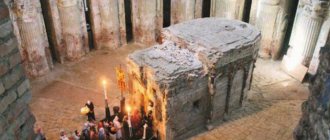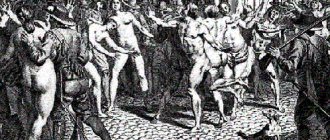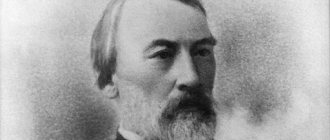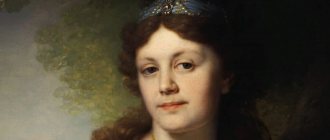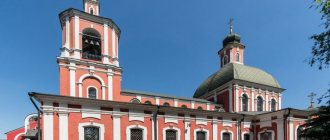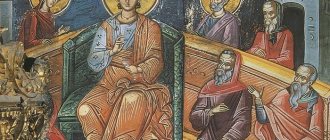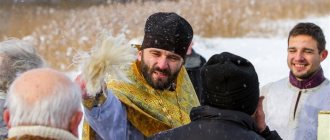Symbolic meaning
Since ancient times, especially in large cathedrals, the high place has been arranged in exact accordance with the vision of John the Theologian (he saw the throne, the Lord Almighty sitting on the throne, and next to him sat 24 elders of kings and priests of God - Rev. 4:4). In the central part of the eastern wall of the altar, usually in a niche in the apse, a pulpit (throne) for the bishop (the High Throne) is built on a certain elevation, and below on its sides are benches or seats for priests (see also Cintron (Christianity)).
The high place is the image of the Heavenly Throne. From the history of church decoration
During the time of Saints John Chrysostom and Basil the Great, the “toponymy” of the Orthodox church was very different from the modern one. Visual dominants crossed the temple not across, but along. The gaze of a person entering the temple was attracted by the majestic canopy above the altar, which was practically not hidden by the altar barrier due to the low height of the latter. Behind the throne, at the very eastern wall of the altar, a richly decorated altar or high place was clearly visible.
Since the time of the first Christians
The formation of the co-throne began in the catacomb period of Christianity. We find it already in the underground church of the holy martyr Agnes (Agnes) in Rome. In this ancient church, carved out of limestone, the seat for the bishop is a chair with a back and arms, recessed into the wall of the temple behind the altar.
Eusebius of Caesarea, in his famous description of the temple built in Tire by Bishop Paulinus, mentions “numerous thrones and benches” located in its altar, intended for bishops and presbyters.
Ruins of the Cathedral of Hierapolis (VI century). The border of the altar and the ancient Mountain Place are visible. It consists of semicircular rows of steps. Immediately behind the throne, on the central throne, sat the bishop, on both sides of him, at different heights, were priests.
Researchers suggest that the name “high place” was coined by Saint John Chrysostom, who called it “the high (that is, exalted) throne” in his rite of the Divine Liturgy. This fact clearly indicates the theological significance of the co-throne: just as the bishop or the priest leading the Liturgy becomes the image of Christ, so the high place marks the spiritual Heaven, and the throne standing on it is an indication of the throne of the Heavenly King.
The plan of the co-throne has remained virtually unchanged over the centuries. In its center is the bishop's throne, from which benches or other seats intended for priests radiate in a semicircle. However, in ancient times, the high place could have several rows, and the bishop's throne was located in such a way that the one sitting on it was taller than everyone else, and he was clearly visible to everyone in the temple. This symbolically recalls the description from the Apocalypse: “And immediately I was in the spirit; and behold, a throne stood in heaven, and on the throne was He who sat... And around the throne were twenty-four thrones; and I saw sitting on thrones twenty-four elders, who were clothed in white robes and had golden crowns on their heads” (Rev. 4: 2-4).
It is interesting that in the time of St. John Chrysostom, the bishop preached a sermon directly from his pulpit on a high place. The saint brought the preacher closer to the people, beginning to deliver sermons from the pulpit, which initially caused misunderstanding among many: in those days, the pulpit was intended for the reader.
Monuments of Byzantium
Sintron of the Temple of Saint Irene, Constantinople
In Byzantium, starting from the 6th century, seats for the bishop and his co-servants were combined into a single structure called a sintron. Paul the Silentiary reports that the synthron of the Temple of Sophia of Constantinople was overlaid with silver. Unfortunately, this majestic work of church art has not survived to this day. But the co-altar of the Church of St. Irene, located in close proximity to the St. Sophia Cathedral, has been preserved. This temple was of considerable importance in the liturgical life of the capital of the Romans, acting as a kind of “understudy” of Hagia Sophia. On certain days of the year, recorded by the strict protocol of cathedral services of the empire, the patriarch served here. In particular, Saint John Chrysostom prayed and preached in this church, and his holy relics, brought from the place of exile where he died, resided here for some time. The synthron of the Church of St. Irene is a stone amphitheater consisting of five steps, covering the entire arc of the altar apse in width. In the same way, the high place was arranged in many other temples. Sources mention that the bishop's throne was located on the top step of the amphitheater, while the seats of the concelebrants were lower and could be located in several rows. The ascent of the bishop to the heights of a mountainous place was understood by interpreters, in particular, Blessed Simeon of Thessalonica, as a reminder of the Ascension of the Lord, as well as of the spiritual ascent from earthly to heavenly, to which every Christian is called.
Due to the theological significance of the bishop's throne, located in the center of the co-throne, it is arranged even in churches that are extremely rarely visited by the clergy. As is known, a priest performs divine services with the authority delegated to him by the bishop, which is also evident from the liturgical texts. A reminder of this, a sign of the hierarchy and unity of the Church, is the bishop’s place in the altar.
Bishop's throne
Throne of Archbishop Maximian, 6th century, Ravenna
Since ancient times, the bishop's throne was richly decorated, and these decorations had a symbolic meaning. Thus, carved in the 3rd century A.D. The marble throne-cathedra of the holy martyr Hippolytus is decorated with images of the heads of some fantastic creatures. Often, bishop's thrones were decorated with sculptural images of lions and even dogs' heads - obviously as a sign of courage, fidelity and spiritual wakefulness. One could see on them a figurine of a dove, as well as outlandish griffins - zoomorphic winged creatures. The Archbishop's Museum of Ravenna preserves the throne of Archbishop Maximian, made in the mid-6th century, which previously adorned the Church of St. Vitaly. It is lined on all sides with ivory plates, covered with carved images of the finest work. Let us note that the tradition of making thrones from this particular material goes back to the throne of King Solomon, mentioned in the Bible: “And the king made a great throne of ivory and overlaid it with pure gold; there were six steps to the throne; the top behind the throne was round, and on both sides of the seat there were elbows, and two lions stood at the elbows...” (Book of III Kings, 10, 18-20). The carver's art captured the images of the Savior, the four Evangelists, and St. John the Baptist. The apostles are dressed in long antique robes and resemble Roman and Greek sages. The figure of the Blessed Virgin Mary in the scene of the Nativity of Christ is filled with tender grace. The scenes from the life of Joseph the Beautiful and from the earthly life of the Savior are filled with internal dynamics and emotionality. Among the latter there are compositions on apocryphal themes, in particular, “The Test of the Mother of God by Water.” Magnificent ornaments complete the impression. Luxurious vines descend from top to bottom and run along horizontal friezes, creating division of the composition. Among the most detailed shoots, clusters and leaves hide majestic peacocks and tremulous deer. Lions with frowning muzzles fall to a vessel with water, a long-eared hare touchingly holds a bunch of grapes with its paws... The artist does not always observe the proportions, so among the vines are hidden ducks, goats, bulls, deer, depicted approximately the same size, and some birds resembling a swallow. ... Probably all these are images of human souls feeding on the grace of the Sacraments of the Church. The boldness of the decision of the throne is noteworthy: it turns out that the icon images were located behind the back and even behind the legs of the person sitting on it.
Stationary altars made of stone were also found in some ancient Russian churches. Thus, in Veliky Novgorod, in the Church of the Transfiguration of the Lord on Ilyin Street, built in 1374, a stone bishop’s throne with an arched bench diverging from it, attached to the semicircular eastern wall of the altar, has been preserved. At a later time, thrones and benches on high places began to be made primarily portable, carving them out of wood.
Nowadays
1. Throne on the High Place of the Cathedral of the Kursk Root Hermitage
Nowadays, when decorating a temple, they try to visually highlight the high place, thereby emphasizing its spiritual and symbolic meaning. According to the tradition established in the Orthodox Church, this part of the altar is usually visible to the laity only through the open Royal Doors. The visual dominant is the icon located on a high place and the throne located under it. In cathedrals it is often placed under a solemnly decorated canopy.
Such a canopy on a high place, created by the masters of the Holy Trinity Brotherhood in the city of Shchigra, is located in the Annunciation Cathedral in Voronezh. It bears the same artistic solutions as the iconostasis: carved wood of a reddish tone, openwork gilded carving of columns and inserts made of natural colored stone echo the altar barrier, creating a harmonious unity.
2. High place of the Epiphany Church, Moscow
The decision of the high place in the altar of the Kursk Root Hermitage embodied theological symbolism and semantic continuity with the works of ancient masters. The bishop's throne is magnificent. Its armrests rest on the heads of lions - a motif that came from the throne of King Solomon and was used in different eras in decorating the thrones of spiritual and temporal rulers. The ornaments combine motifs of vines and paradise plants. The bright gilding of the throne is combined with the same gilding decorating the iconostasis and the decoration of the altar. Above the throne rises an icon case with a life-size image of the Blessed Virgin Mary in a gilded frame. This frame consists of carved columns and several rows of voluminous patterned cornices. The structure is crowned with a cross, under which is an image of a six-winged seraphim. Thus, the icon case simultaneously becomes a kind of canopy on a mountainous place. On either side of it there are semicircular benches for priests. A stylistic continuation of the bishop's throne can be called a seat for the bishop, installed on the pulpit in the central part of the cathedral at certain moments of the service. Having no back and more modest in decoration, it is decorated with sculpted carved heads and paws of lions.
In the Epiphany Church on Nikolskaya Street in Moscow, the space of the High Place is highlighted by a carved canopy made of light wood and the same icon cases. The ornaments decorating it echo the vestments of the throne and the altar. The restrained altar decoration looks detailed and complete.
Alina Sergeychuk
Photos 1–5 show the work of masters of the Holy Trinity Brotherhood in the city of Shigri, www.shigri.ru
The mountainous place of the Cathedral of the Kursk Root Hermitage
A bit of symbolism: The high place of the Orthodox church with the bishop's throne brings us the most important symbolic meanings, speaking about the unity of the Church. These days this idea is especially relevant. This unity, like many things in Christianity, has several levels. The simplest is the hierarchical connection of all Orthodox Christians, from the Patriarch to the simple pilgrim. It is impossible to become a priest without ordination from a bishop. It is impossible to consecrate a temple without an antimension given by the Hierarchy. There cannot be the Sacraments of the Church without the priesthood. Another meaning is historical continuity, the unity of all generations of the earthly Church. Every Orthodox priest, through a long chain of generations, has continuity from the apostles, and, accordingly, from the Savior Himself, who sent His disciples to preach. This means that there cannot be grace on the followers of schismatics and heretics who have fallen away from church unity, who have lost grace and, in this sad state, illegally performed ordinations. Finally, church unity is the community of the earthly and heavenly Church: each of us - and the saints who are at the Throne of the Almighty.
Highest place in worship
In the Orthodox Church, during hierarchal services on statutory occasions, in particular when reading the Apostle during the liturgy, the bishop sits on the seat, and the clergy serving with him are located respectively on the sides. With this arrangement, the bishop represents Christ the Pantocrator, and the clergy – the apostles or those elder priests whom John the Theologian saw. The bishop, who is in a high place, and the priests listen to the reading of the Gospel while standing.
The high place is a designation of the mysterious presence of God and those who serve him. Therefore, this place is always given due honors, even if, as is often the case in parish churches, it is not decorated with a dais with a seat for the bishop. In such cases, only the presence of a lamp in this place is considered mandatory: a lamp, or a tall candlestick, or both. During the consecration of the temple, after the altar has been consecrated, the bishop with his own hand must light and place the lamp in a high place. The anointing of the church to be consecrated begins from the throne on the side of the high place, on the wall of which a cross is drawn with myrrh.
Patristic testimonies
There is evidence from the holy fathers that the sermon was delivered while sitting from a high place.
1) Saint Gregory the Theologian (325–389), in Homily 42, asking a meeting of 150 bishops to let him retire for his labors, said: “Forgive the pulpit (ὦ καθέδρα) [8] - this enviable and dangerous height; forgive the council of bishops and priests, venerable in rank and years; ...Forgive lovers of my words, forgive these popular trends and confluences, and these canes, writing openly and secretly, and this lattice, which can barely withstand those crowding to listen!”[9].
2) In the poem “Dream”, about the Church of Anastasia, which St. Gregory the Theologian built in the capital, he writes: “I imagined that I was sitting on a high throne, but not with my eyebrows raised high; no, and in my dreams I never served pride. On both sides below me sat the elders[10], the leaders of the herd, differing in age. The servants[11] stood in bright robes, like images of angelic radiance. Some of the people, like bees, huddled against the bars, and everyone tried to come closer; others crowded into the sacred vestibules, equally hastening with their ears and feet; and others were led further to hear my words by the colorful marketplaces and the streets resounding under their feet. Pure maidens, together with well-behaved wives, bowed down to the dean’s ears from high roofs.”[12]
3) Saint Gregory of Nyssa (335–394), in his sermon on Epiphany, says: “I confess that I suffer from pastoral suffering: sitting on this high seat (ἐπί τῆς ὑψηλῆς ταύτης καθήμενος)[13], I wish to see what is gathered around, as if at the foot of a mountain peak, a herd. And when this happens, I am full of amazing joy and the word is as pleasant a work for me as shepherd’s songs are for shepherds.”[14]
4) The historian Socrates Scholasticus (380–439) in his “Ecclesiastical History” (Book VI, Chapter 16), narrating the return of St. John Chrysostom (354–407) from exile, reports that the saint preached a sermon from a high place, that was the custom at that time. “Numerous crowds of people came out to meet him and with the greatest honors led him straight to the church. Here the people asked him to sit on the episcopal throne (τῷ ἐπισκοπικῷ θρóνῳ) and, as usual, teach peace to those around him. When John began to refuse, saying that he could only do this by the verdict of the judges and that the previous judges must first acquit him, the people became even more inflamed with the desire to see John on the episcopal throne (τῷ θρóνῳ) and to hear his teaching - and finally persuaded him to this. John sat on the episcopal throne (τóν ἐπισκοπικóν θρóνῳον) and, as usual, proclaimed peace to the people and even, yielding to necessity, delivered a sermon.”[15]
Literature
- Gaidukov N. E.
[www.pravenc.ru/text/166223.html Mountainous place] // Orthodox Encyclopedia. Volume XII. - M.: Church-scientific, 2006. - P. 120-122. — 752 p. — 39,000 copies. — ISBN 5-89572-017-Х - Petrovsky A.V.
[www.biblioteka3.ru/biblioteka/pravoslavnaja-bogoslovskaja-jenciklopedija/tom-4/gornee-mesto.html Mountainous place] // Orthodox Theological Encyclopedia. - St. Petersburg: Petrograd Publishing House. Supplement to the spiritual magazine “Wanderer”, 1903. - Vol. 4. - Trapeznikov A.
Temple, Rituals, Worship. - M.: Veche, 2007.
An excerpt characterizing the High Place
It was so light that he saw the plaques and eyes of the horses glinting in the monthly light, looking back in fear at the riders rustling under the dark awning of the entrance. Natasha, Sonya, m me Schoss and two girls got into Nikolai’s sleigh. Dimmler and his wife and Petya sat in the old count’s sleigh; Dressed up servants sat in the rest. - Go ahead, Zakhar! - Nikolai shouted to his father’s coachman in order to have a chance to overtake him on the road. The old count's troika, in which Dimmler and the other mummers sat, squealed with their runners, as if frozen to the snow, and rattled a thick bell, moved forward. The ones attached to them pressed against the shafts and got stuck, turning out the strong and shiny snow like sugar. Nikolai set off after the first three; The others made noise and screamed from behind. At first we rode at a small trot along a narrow road. While driving past the garden, shadows from bare trees often lay across the road and hid the bright light of the moon, but as soon as we left the fence, a diamond-shiny snowy plain with a bluish sheen, all bathed in a monthly glow and motionless, opened up on all sides. Once, once, a bump hit the front sleigh; in the same way, the next sleigh and the next were pushed and, boldly breaking the chained silence, one after another the sleighs began to stretch out. - A hare's trail, a lot of tracks! – Natasha’s voice sounded in the frozen, frozen air. – Apparently, Nicholas! - said Sonya's voice. – Nikolai looked back at Sonya and bent down to take a closer look at her face. Some completely new, sweet face, with black eyebrows and mustache, looked out from the sables in the moonlight, close and far. “It was Sonya before,” thought Nikolai. He looked at her closer and smiled. – What are you, Nicholas? “Nothing,” he said and turned back to the horses. Having arrived on a rough, large road, oiled with runners and all covered with traces of thorns, visible in the light of the moon, the horses themselves began to tighten the reins and speed up. The left one, bending its head, twitched its lines in jumps. The root swayed, moving its ears, as if asking: “should we start or is it too early?” – Ahead, already far away and ringing like a thick bell receding, Zakhar’s black troika was clearly visible on the white snow. Shouting and laughter and the voices of those dressed up were heard from his sleigh. “Well, you dear ones,” Nikolai shouted, tugging on the reins on one side and withdrawing his hand with the whip. And only by the wind that had become stronger, as if to meet it, and by the twitching of the fasteners, which were tightening and increasing their speed, was it noticeable how fast the troika flew. Nikolai looked back. Screaming and screaming, waving whips and forcing the indigenous people to jump, the other troikas kept pace. The root steadfastly swayed under the arc, not thinking of knocking it down and promising to push it again and again when necessary. Nikolai caught up with the top three. They drove down some mountain and onto a widely traveled road through a meadow near a river. “Where are we going?” thought Nikolai. - “It should be along a slanting meadow. But no, this is something new that I have never seen. This is not a slanting meadow or Demkina Mountain, but God knows what it is! This is something new and magical. Well, whatever it is!” And he, shouting at the horses, began to go around the first three. Zakhar reined in the horses and turned around his face, which was already frozen to the eyebrows. Nikolai started his horses; Zakhar, stretching his arms forward, smacked his lips and let his people go. “Well, hold on, master,” he said. “The troikas flew even faster nearby, and the legs of the galloping horses quickly changed. Nikolai began to take the lead. Zakhar, without changing the position of his outstretched arms, raised one hand with the reins. “You’re lying, master,” he shouted to Nikolai. Nikolai galloped all the horses and overtook Zakhar. The horses covered the faces of their riders with fine, dry snow, and near them there was the sound of frequent rumblings and the tangling of fast-moving legs and the shadows of the overtaking troika. The whistling of runners through the snow and women's squeals were heard from different directions.
